This post contains affiliate links.
As hummingbird aficionados seek to attract these delightful creatures, a question often flutters to mind: do hummingbirds prefer natural blooms or the allure of feeders?
As a seasoned hummingbird observer, I find my hummingbirds like both my feeders and flowers equally.
To learn more about what feeders hummingbirds are attracted to read my article:
Red Hummingbird Feeders: (Essential or Optional)
In this article, I will delve into the botanical buffet that best tempted these avian acrobats to my backyard, exploring an array of flora that transformed my backyard and will transform your garden into a hummingbird haven.
I hope you enjoy my article as I uncover the most enticing plants to ensure your outdoor space is abuzz with the flutter of hummingbird wings.
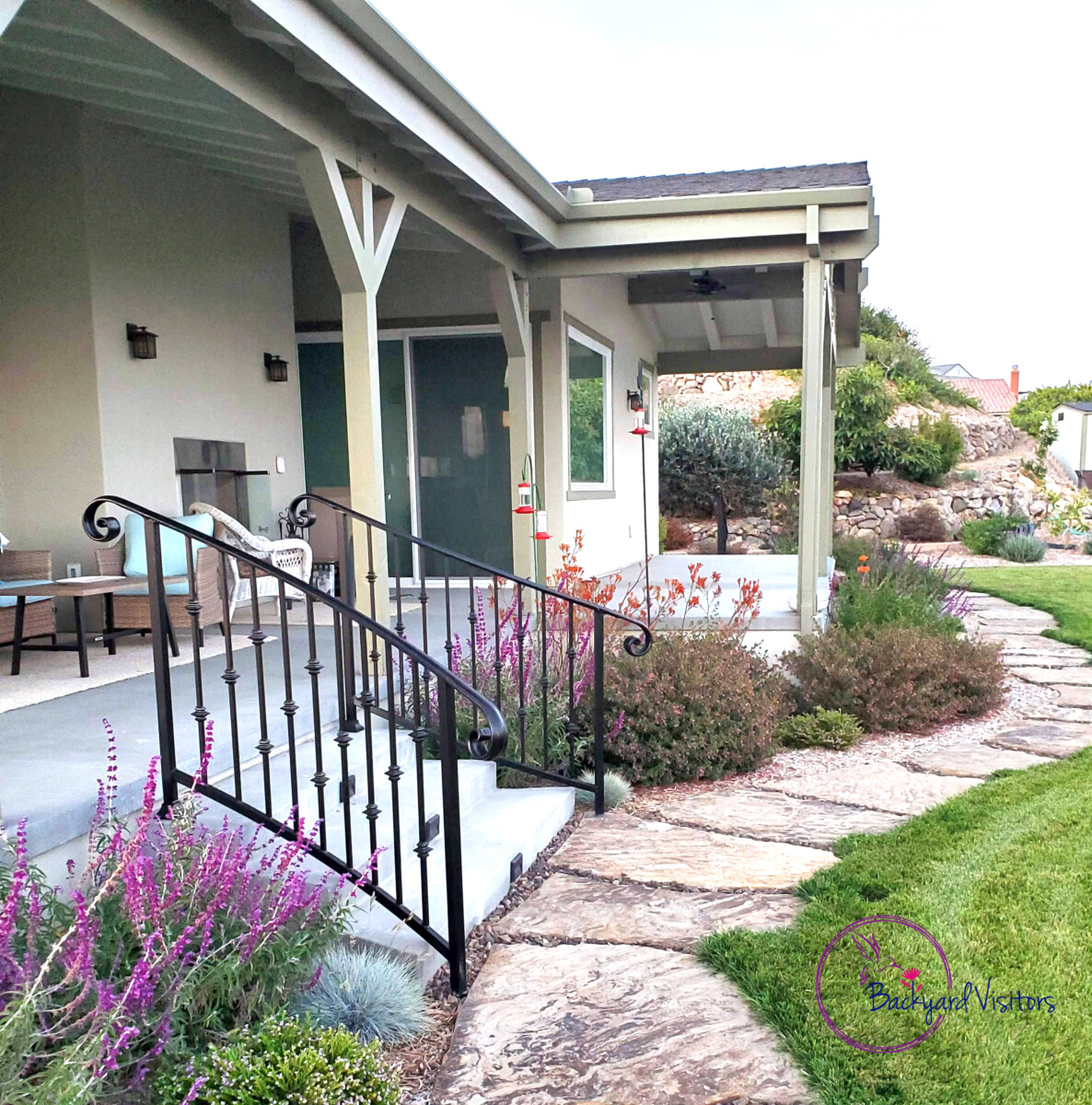
The hillside behind the house
is entirely planted with hummingbird plants.
Creating a Hummingbird Garden with Floral Abundance for Hummers
For avid hummingbird enthusiasts, the allure of attracting hummingbirds to their yard transcends mere hobby; it is a passion colored with flashes of iridescent feathers and the soft hum of wings in motion. Whether these adorable hummers are more attracted to flowers than feeders is a recurring topic in many gardens.
To create a hummingbird garden that promises an enchanting floral abundance, it is crucial to understand the preferences of these avian visitors. Flowering plants with their nectar-rich blooms are, without a doubt, a natural magnet for hummingbird visits.
Hummingbirds have co-evolved with flowers, tuning their impressive acrobatic flight abilities into sipping nectar from blooms that range from the trumpet-shaped to the clustered and tubular.
In constructing an idyllic hummingbird garden, incorporating a mix of native plants has an astounding impact. Native plants, fashioned by nature to flourish in local climates, ensures a generous bounty of flower visits through the seasons. These include vibrant Salvia, Fuchsia, and Trumpet Vines known for their natural high nectar production, the perfect hummingbird nectar.
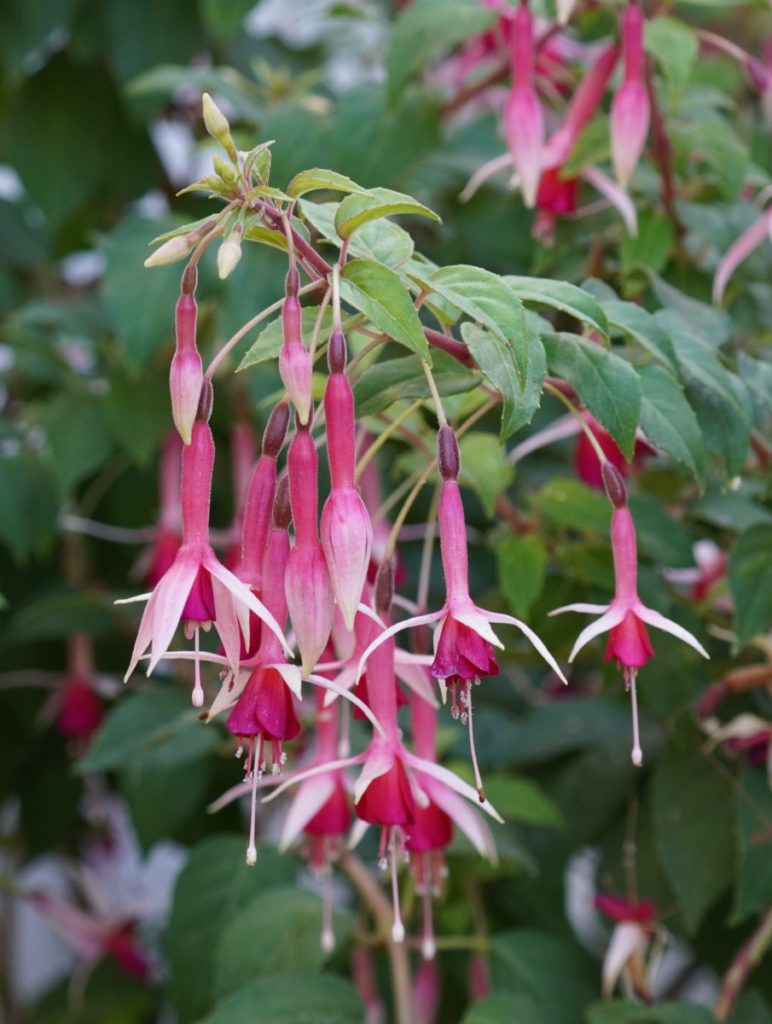
The beauty of floral abundance with native plants is their innate ability to provide the sustenance that hummers require, ensuring that feeder visits, while still welcomed, are more complementary.
What about the charming hummingbird feeders that homeowners frequently scatter among the foliage? While feeders are indeed effective in attracting hummingbirds, they serve more as a supplement to the nectar acquired from flowers.
Though a joy to observe the routine of feeder visits, to truly entice these flying jewels, a garden filled with varied and diverse flowering plants is the cornerstone of your efforts. When considering which flowers to plant, a diversity of colors and species is key, as it imitates the hummers’ natural buffet, offering a range of flowers to meet their dietary and migratory needs. A feasting spot created with a floral abundance of flowers turns your garden into a buzzing hub of hummingbird activity.
As the hummingbirds start their migration in the early spring the Crocus (Crocus spp.) provide a crucial nectar source for these birds as these flowers are often seen popping up from under a blanket of snow. In the late fall the Jewelweed (Impatiens spp.) Tubular flowers provide a late-season food source before the hummingbirds migrate south for the winter.
Strategic garden planning ensures a steady succession of blooming plants from early spring through late fall. Selecting flowering plants that cover this spectrum, provides a consistent source of nectar throughout the hummingbirds’ visiting months.
Below is a list of flowers that bloom from early spring to late fall, known to attract hummingbirds:
- Early Spring:
- Crocus (Crocus spp.)
- Lungwort (Pulmonaria spp.)
- Late Spring:
- Bleeding Heart (Dicentra spp.)
- Columbine (Aquilegia spp.)
- Foxglove (Digitalis spp.)
- Early Summer:
- Bee Balm (Monarda spp.)
- Salvia (Salvia spp.)
- Penstemon (Penstemon spp.)
- Mid-Summer:
- Trumpet Vine (Campsis radicans)
- Cardinal Flower (Lobelia cardinalis)
- Butterfly Bush (Buddleja spp.)
- Late Summer to Early Fall:
- Russian Sage (Perovskia atriplicifolia)
- Joe Pye Weed (Eutrochium spp.)
- Autumn Sage (Salvia greggii)
- Late Fall:
- Jewelweed (Impatiens spp.)
Planting a variety of these flowers throughout the growing season helps attract and support hummingbirds in your garden from early spring to late fall.
Additionally, providing supplemental nectar through hummingbird feeders ensures a consistent food source for these delightful birds throughout the year.
Layer your space with varying heights, from ground covers to tall spikes and shrubs, cultivating a tiered effect that allows hummers to zip in and out with ease. By doing so, the drawing power of your garden is significantly amplified, making it irresistible to the hummingbirds, which have an insatiable penchant for both flowers and hummingbird-feeders.
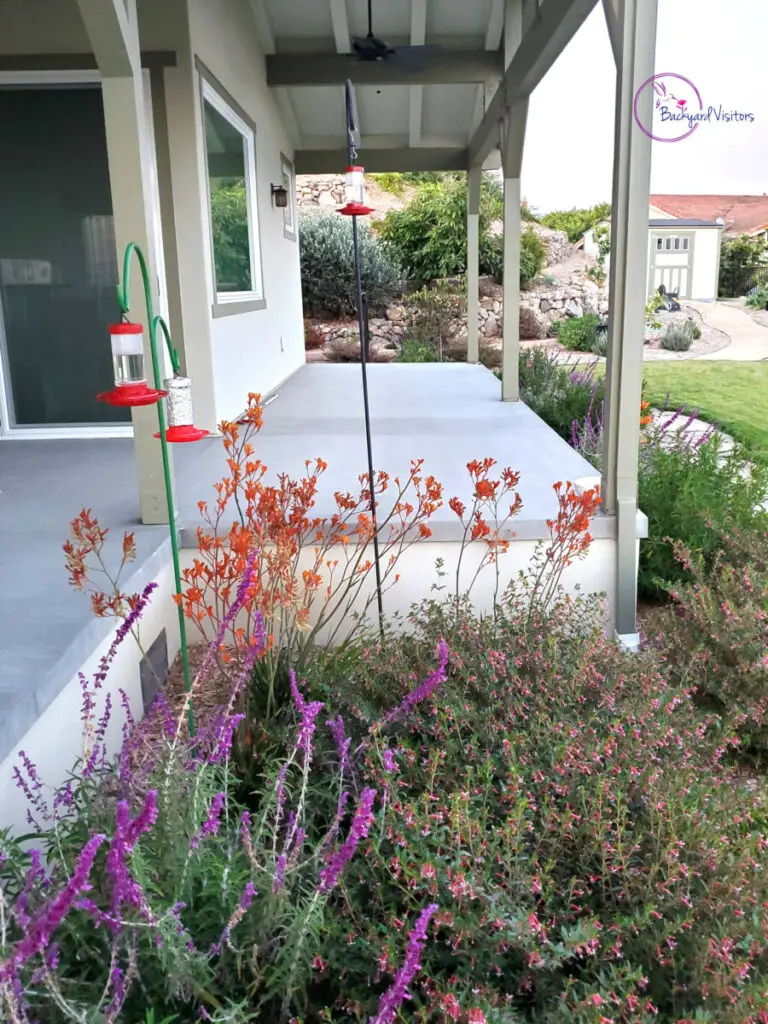
Pink Cigar Plant – (Cuphea ‘Kristen’s Delight’)
Kangaroo Paw – (Anigozanthos)
As you sculpt this paradise, remember the words ‘floral abundance’—a mantra that encapsulates the essence of your intent to create a refuge for these fast-flying pollinators.
The ethereal dance around hummingbird-feeders or the cherished depths of flower visits, what truly captivates the hummers is a habitat rich in variety and natural nourishment. By prioritizing floral abundance in your hummingbird garden, interspersed with strategic feeder placements, you will witness a flurry of hummingbird visits throughout the season.
Embrace the symphony of flowers and feeders, and let your garden become a bustling hub of life, where every splash of color is a testament of your dedication to these extraordinary birds, our cherished hummers.
Below is a list of ways, in order of importance, in creating a hummingbird garden:
- Choose a suitable location that provides a mix of sun and shade throughout the day.
- Select native flowering plants that provide nectar throughout the growing season.
- Plant a variety of flower colors, especially reds and purples, known to attract hummingbirds.
- Group the same plants together to create a bold display that is easily visible to hummingbirds.
- Incorporate different flowering plant heights and types to cater to the feeding preferences of hummingbirds.
- Add a water feature such as a misting fountain or birdbath to provide a source of freshwater.
- Avoid using pesticides or chemicals that will harm the hummingbirds or their food sources.
- Place hummingbird feeders filled with sugar water to supplement natural nectar sources, especially in early spring and late fall.
- Ensure continuous bloom by selecting plants with staggered blooming periods.
- Offer perching and nesting sites by including trees, shrubs, and nesting material.
- Maintain the garden regularly to remove dead flowers and invasive species that will compete with beneficial plants.
The Best Plants to Feed Hummingbirds with Natural Flowers
When endeavoring to create a paradise for our iridescent friends, the question often arises, do hummingbirds prefer flowers or feeders? While feeders are a fantastic method for attracting hummingbirds and providing them with easy access to food, there is an undeniable allure to the natural beauty and ecological benefits that come with flowering plants.
The best way to ensure a hummingbird garden resonates with the hum of tiny wings is not merely through offering feeders, but by incorporating the best native plants that provide the floral abundance that hummingbirds love.
Think of your garden as a banquet hall for these flying jewels. To optimize the availability of hummingbird nectar, select the plants with care, favoring those that offer abundant nectar. The best plants are often those that coevolved with hummingbirds, and in many areas, these are the native plants that grow easily and abundantly flourish.
Plants such as the vibrant Trumpet Vine, the fiery Red Cardinal Flower, or the brilliant purple blossoms of Salvias are true nectar magnets. Flowering plants such as the Fuchsia, whose pendulous blooms are practically designed for a hummingbird’s long bill, or the fiery spikes of the Red Hot Poker, provide not just food, but also provide a visual feast as you watch in awe at the acrobatics of your avian visitors.
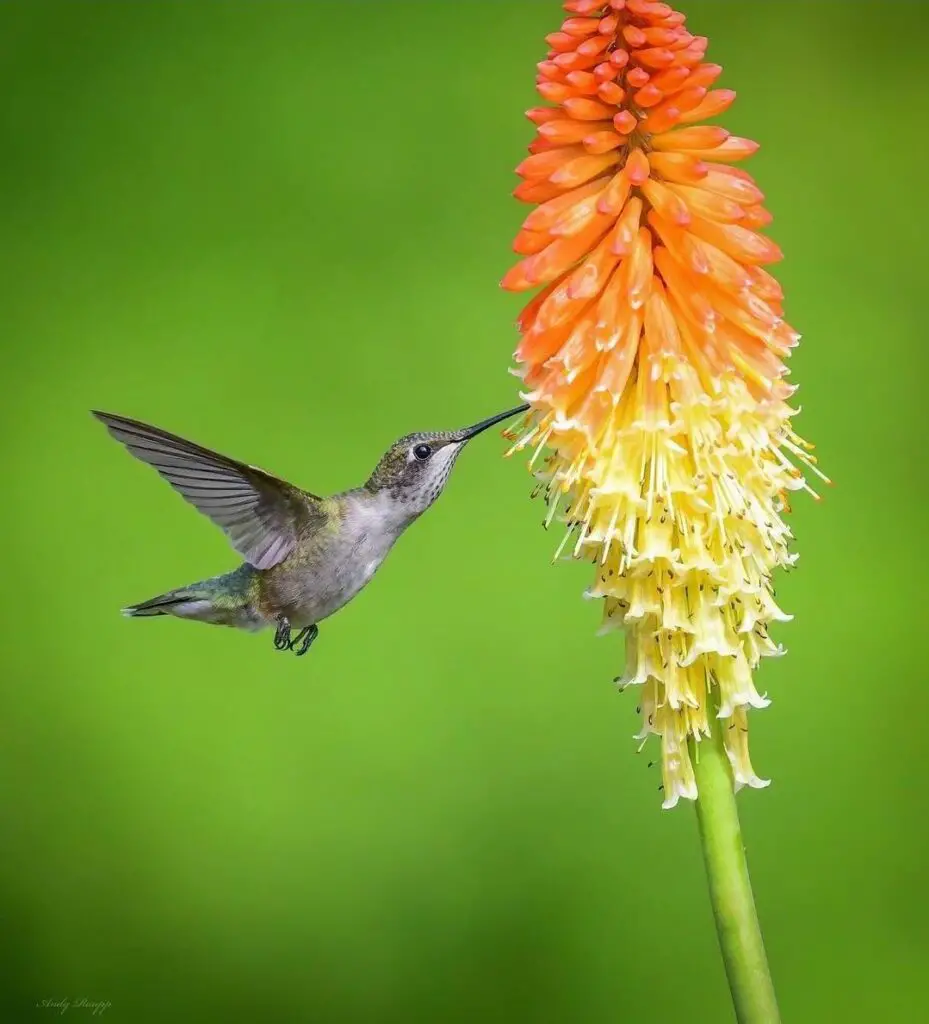
Red Hot Poker Plant
Photo by: Andy Raupp
A diversity of plant species ensures a longer blooming season, meaning that flowers will offer nectar at different times, ensuring continuous food sources for hummingbirds.
When selecting plants, aim for those that bloom at varying intervals. This staggering of floral abundance throughout the seasons not only sustains the hummingbirds’ need for food but turns your garden into a year-round haven for both the resident and the migratory species.
In the late spring and early summer, nectar producing flowering plants such as the Columbine (Aquilegia spp.) and Salvia (Salvia spp.) have prominent blooms. Many species of salvia, such as Scarlet Sage (Salvia coccinea) and Black and Blue Salvia (Salvia guaranitica), are excellent nectar sources for hummingbirds.
From mid-summer to late fall the Cardinal Flower (Lobelia cardinalis), Butterfly Bush (Buddleja spp.) and Autumn Sage (Salvia greggii) provide valuable nectar sources for hummingbirds for the next half of the year.
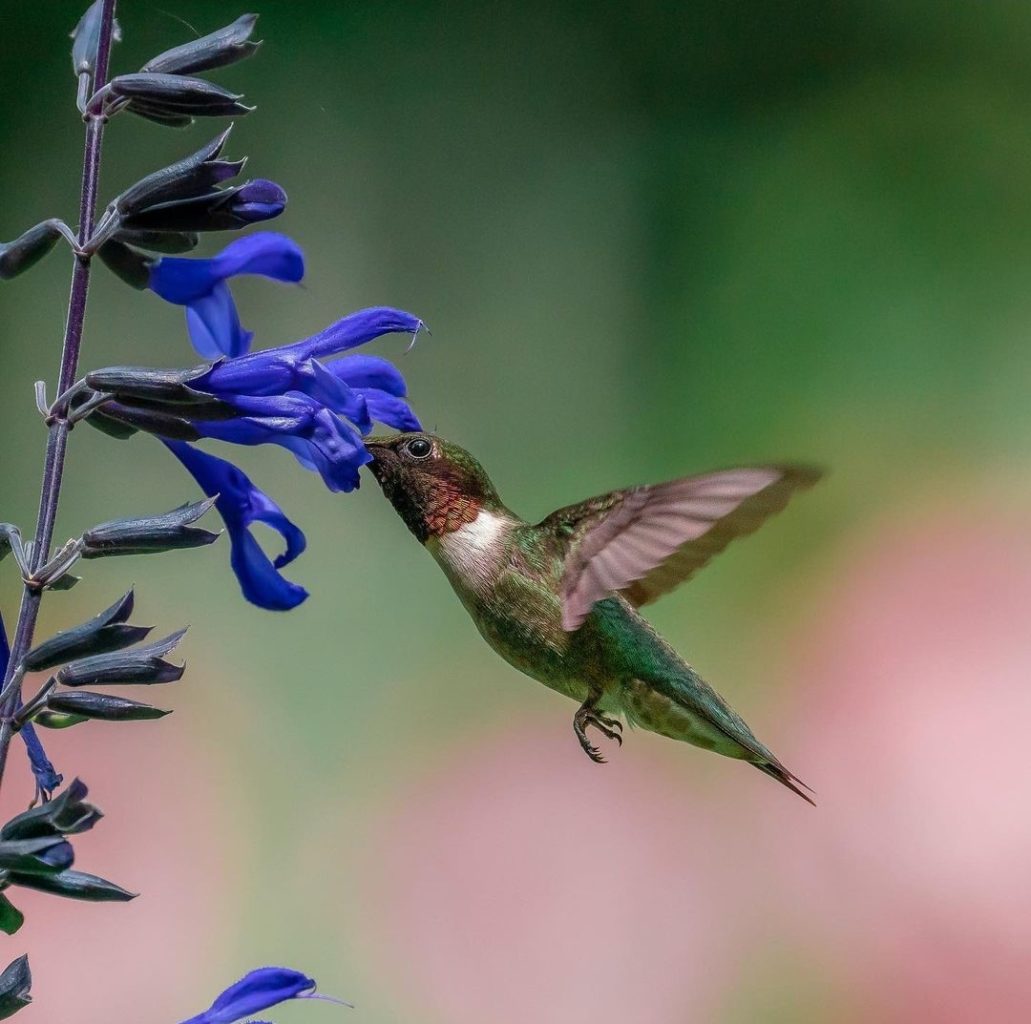
Black and Blue – (Salvia guaranitica)
Photo by: Aaron Cutler
As critical as feeders are, especially during migration when hummingbirds need to refuel frequently, flowers provide more than just food; they supply essential micronutrients that feeders alone cannot offer.
Furthermore, the natural way in which flowers display their abundance promotes foraging habits, which is one of the main reasons that real flowers are frequently regarded as the greatest source of nectar for hummingbirds.
Do not discount the role of feeders in attracting hummingbirds. By offering homemade sugar water, feeders mimic natural nectar and are excellent at attracting these birds to your garden, ensuring that they come close enough for you to appreciate their iridescence and aerial maneuvers.
Feeders also play a crucial role during times when plants are not in bloom, and provide a steady source of food.
To truly cater to the preferences of hummingbirds, integrate a variety of best-blooming plants into your landscape. Your hummingbird garden will be a mosaic of colors and shapes, providing both visual and gustatory delights.
Options such as Bee Balm, Columbine, and Zinnias provide the variety needed to keep hummingbirds returning. These plants are especially valuable since they offer not just nectar, but also attract insects, which serve as a necessary protein source for hummingbirds.

Zinnia Plant
Photo by: Mz13hummingbirds
Though feeders are essential, to truly engage the hearts and appetites of our feathered friends, invest in the best flowering plants that provide not only food but also the natural habitats hummingbirds love. By fostering a garden rich in flowers, you are not only providing a sanctuary for these enchanting birds but also contributing to the health of our native plant species and ecosystems, making each flutter and buzz a testament to a well-nourished hummingbird paradise.

Lantana Plant
Photo by: Andy Raupp
Below are the most nectar producing flowers to attract hummingbirds:
- Bee Balm (Monarda)
- Zinnias (Zinnia spp.)
- Salvia (Salvia spp.)
- Trumpet vine (Campsis radicans)
- Cardinal Flower (Lobelia cardinalis)
- Lupines (Lupinus spp.)
- Columbine (Aquilegia spp.)
- Penstemon (Penstemon spp.)
- Butterfly Bush (Buddleia davidii)
- Fuchsia (Fuchsia spp.)
- Petunias (Petunia spp.)
- Foxgloves (Digitalis spp.)
- Coral Bells (Heuchera spp.)
- Lantana (Lantana camara)
- Impatiens (Impatiens spp.)
- Agastache (Agastache spp.)
- Red Hot Pokers (Kniphofia spp.)
- Phlox (Phlox spp.)
- Scarlet Sage (Salvia splendens)
- Honeysuckle (Lonicera spp.)
Why Hummers Favor Flowers: The Importance of Flowering Plants
Hummingbirds are truly marvels of nature. Their heartbeat pulsates like a rapid symphony, and their wings flutter with a blur that captivates any observer. When it comes to their sustenance, one often ponders, do hummingbirds prefer flowers or feeders? The answer is not rooted in their dining preferences; it is intertwined with their biological needs and ecological relationships.
Flowering plants offer a smorgasbord of nourishment, and hummers have co-evolved with these floral buffets over millennia. The role of flowers is deeply intrinsic, as they provide not only essential nectar but also insects, which are imperative for a balanced diet, especially during breeding season.
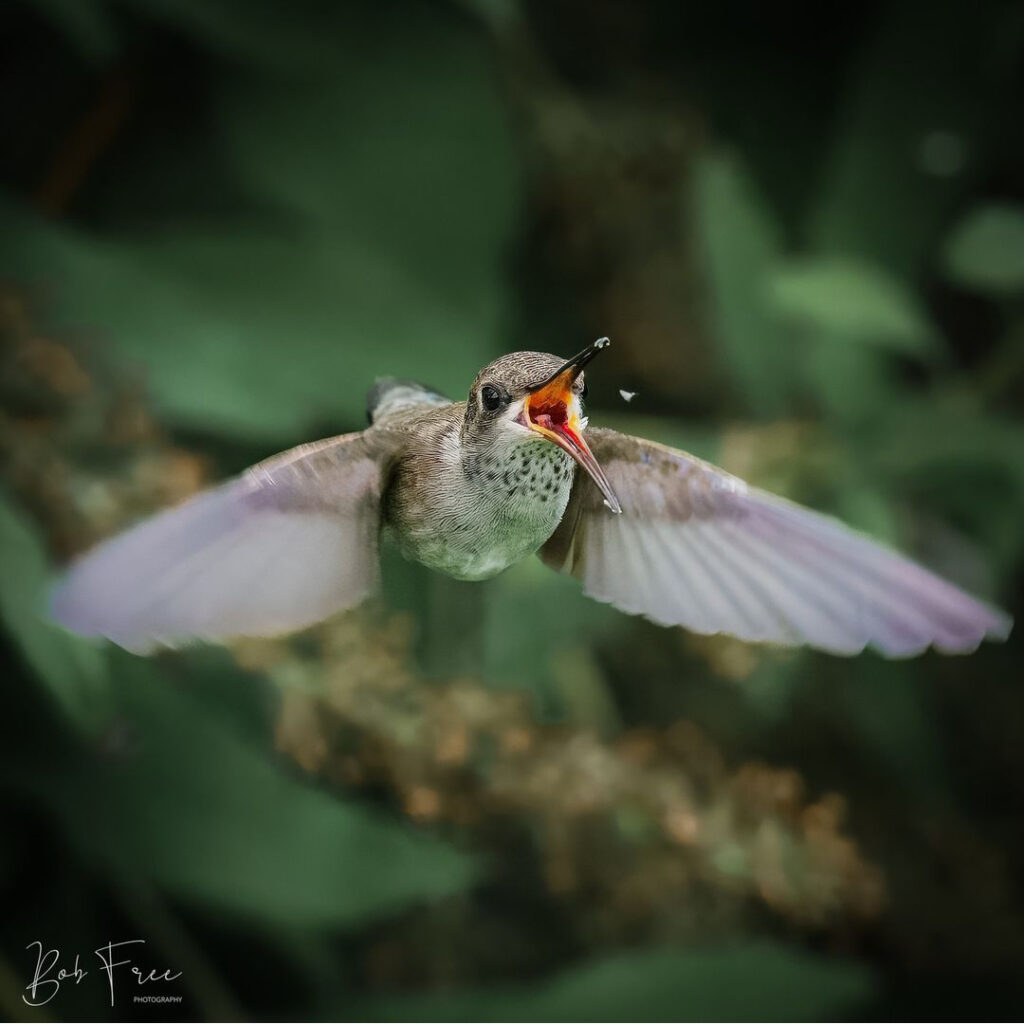
Photo by: Bob Free
Hummingbirds love converging upon blooming flowers as they are drawn in by the vibrant petals which serve as neon signs advertising a natural refueling station.
The best strategy to attract these shimmering creatures is by planting a garden where flowers are plenty, ensuring a habitat that mimics their natural environment.
The best plants for hummers are those they prefer naturally. The hummingbirds’ long standing love of long tubular flowers such as Salvia or Penstemon is no secret. The design of the hummingbird’s beak allows for exclusive access to the nectar in these flowers, which hold the precious energy for these hummingbirds.
My backyard is configured with multiple plantings of the Cigar plant (Cuphea ignea) just below the hanging feeders. These tubular flowers are designed perfectly to accommodate the hummingbird’s beak and to also provide the most nectar.This backyard configuration allows the hummingbirds to migrate back and forth between the flowers and the feeders. It also provides hiding spots and resting areas for the less aggressive hummingbirds as they patiently sit and wait their turn on the feeder.
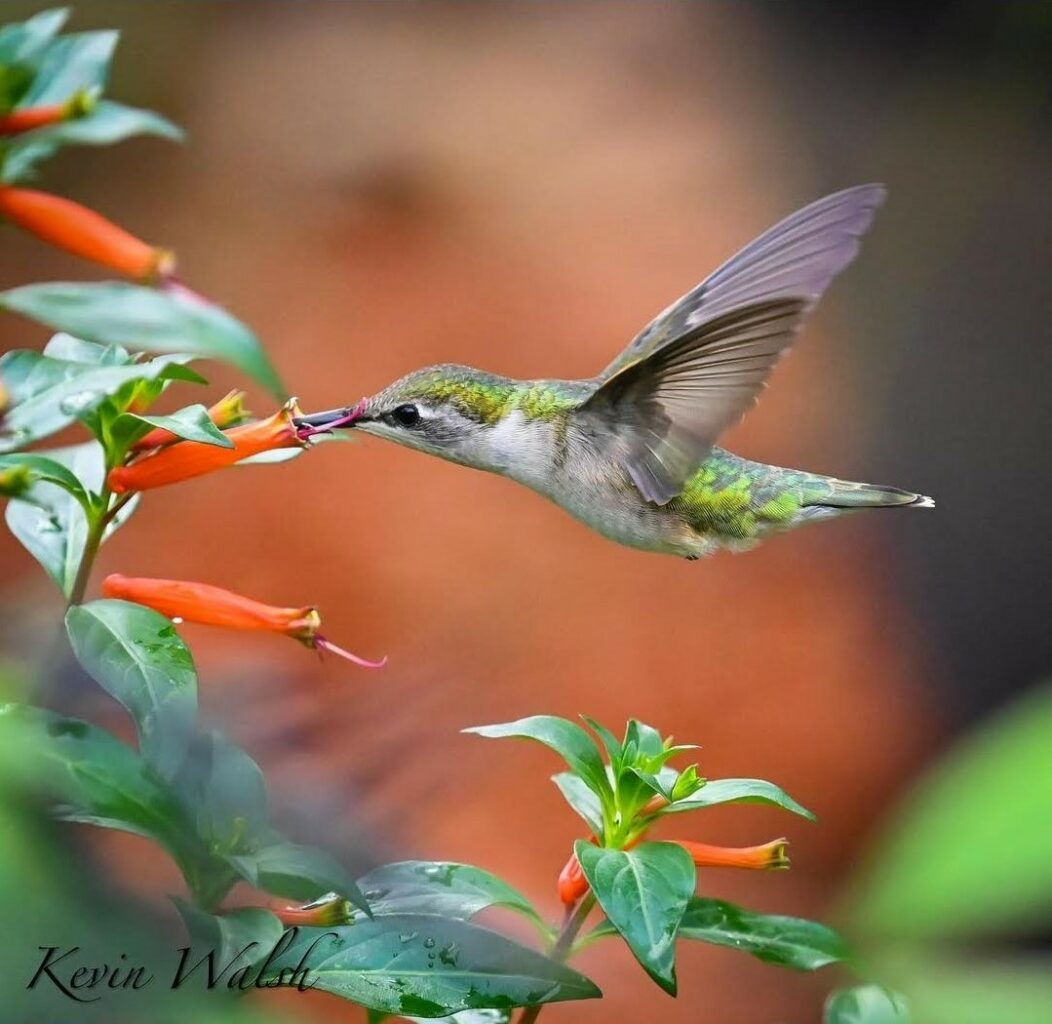
Cigar Plant – (Cuphea ignea)
Photo by: Kevin Walsh
While hummingbirds feeders are very beneficial, particularly in urban areas where natural flora is less abundant than in rural areas, they are no substitute for the complexity and full nutritional profile provided by flowering plants. Native plants serve as the best option, since they have developed alongside the local hummingbird species, creating a co-dependent relationship where both parties thrive.
Regional flowers align with the local hummingbirds’ preferences, making them powerhouses of nutrition and attraction. Preferably, the choice of plantings include a variety of species that bloom at different times, thus offering a steady supply of food across the changing seasons.
Nevertheless, a feeder will complement the diet offered by plants, ensuring that hummers have access to food during scarce periods. The red color of a feeder draws hummingbirds, simulating the allure of flowers. However, feeders must be cleaned regularly to prevent the spread of disease among hummingbird populations.
Read my article: Red Hummingbird Feeders: (Essential or Optional)

Though hummers do relish the sugary solution from the feeders, it lacks the proteins and fats offered from the flower-loving insects, making abundant floral resources the more comprehensive option for their dietary needs.
While feeders serve as a valuable support system, it is the flowers that claim the title for the best source of sustenance for these birds. By filling our gardens with a variety of flowers—especially those native to our region—we are not only encouraging more flower visits but also ensuring the long-term health and vitality of the hummingbird populations.
No wonder gardeners who prefer their yards abuzz with activity focus on planting an ornithological paradise; a sanctuary where hummingbirds find solace and sustenance, thriving amid the nectar-laden blossoms they naturally favor.
Optimizing Your Garden’s Floral Abundance for Hummingbird Attraction
Attracting hummingbirds to one’s garden is a quest tinged with the vibrant flashes and aerobatic displays of these jewel-toned flyers. Gardeners often ponder whether hummingbirds prefer the instant gratification of feeders or the more sustainable offerings of flowers. The truth is, hummingbirds love both, but floral abundance provides much more than just food – it affords natural habitats and a spectrum of nutrients.
When it comes to the perfect hummingbird garden, it is crucial to focus on creating a space where flowers and feeders complement each other to support the varying needs of hummingbirds.
To ensure frequent hummingbird visits, create a garden that mimics the depth of diversity found in their natural environment with an assortment of native and flowering plants. These plants offer more than just nectar; they pack a nutritional punch with other insects and materials on which hummingbirds feed to maintain a balanced diet.
While flowers are the main attraction, scatter some hummingbird-feeders throughout your space filled with the traditional hummingbird simple sugar solution to supplement their diet, especially when flowers are not in full bloom.
Read my article: Forget Commercial Hummingbird Food, Try Making Homemade Nectar
Native plants are the cornerstone of a hummingbird-friendly habitat. They co-evolved with local hummingbird species and thus provide the most accessible source of nectar. These plants also foster a hospitable environment for the insects necessary for the hummingbirds to feed, fortifying their diet with protein.
Among the best plants to entice hummingbirds, add species such as Trumpet Vine, Bee Balm, and Cardinal Flower. Additionally, hummingbirds love to return to the same feeders and plants year after year, as they are creatures of habit.
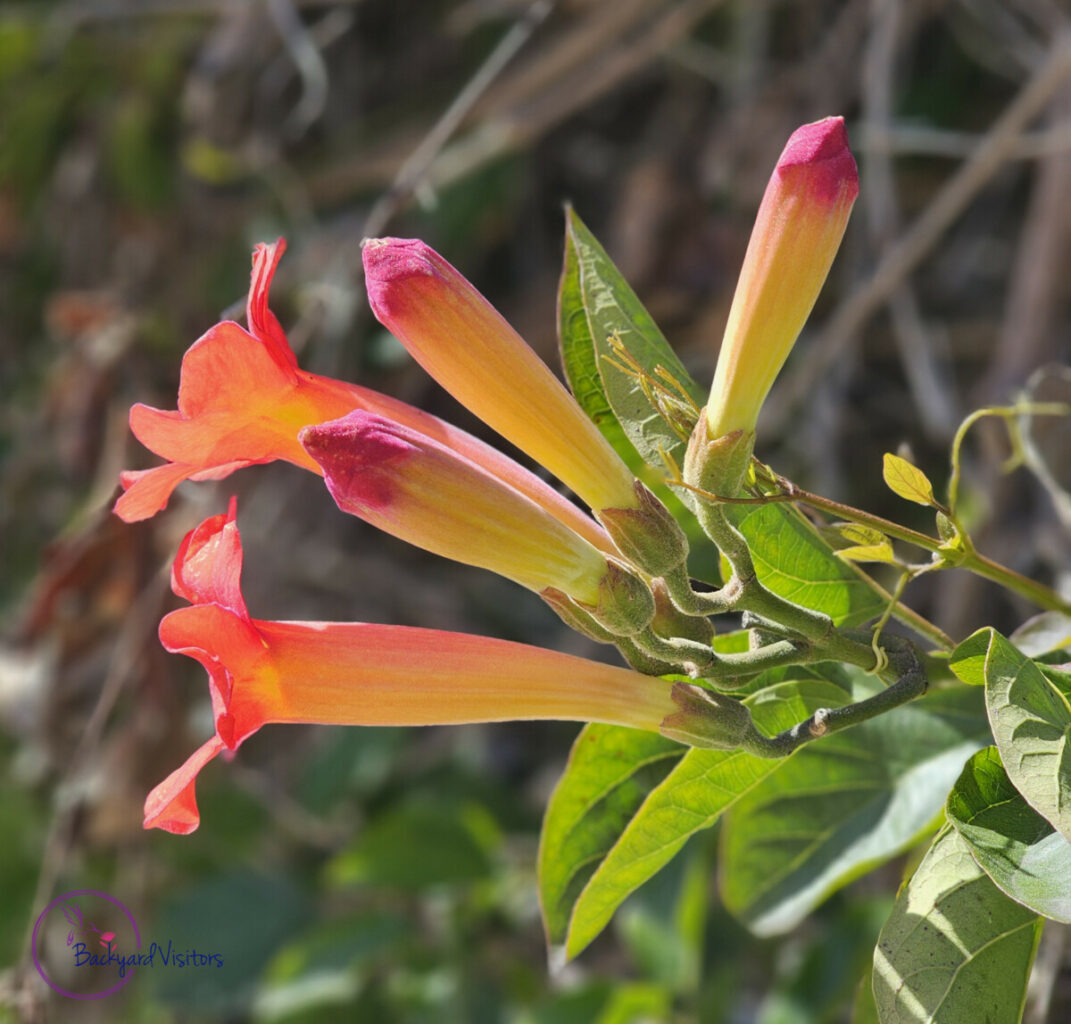
With a mix of the right flowers and feeders, your hummingbird garden becomes a hub of activity. Maintaining floral abundance requires dedicated effort. Flowers require deadheading (removing the spent flowers) to encourage the plant to continue blooming, and feeders must be cleaned regularly to prevent the spread of disease.
Read my article: Hummingbird Diseases: From Pathogens to Prevention
Hummingbirds prefer tubular shaped flowers and vivid hues such as reds and purples since they are viewed as beacons of food amidst the greenery during their aerial navigation. However, it is best to provide a range of colors to attract various species and accommodate different preferences.
Despite the allure of feeders, hummingbirds need the sustenance and shelter that only a varied plant selection provides. When setting up feeders, it is crucial to strategically place them near flowering plants to offer hummingbirds a choice, encouraging natural foraging behavior.
Read my article: How Do Hummingbirds Know You Have a Feeder?
When tailoring your garden, observe the bird’s preferences to create a hummingbird haven. By prioritizing planting over artificial feeding, the opportunity is created for hummingbirds to engage in the activities they love such as darting from flower to flower and living the life nature intended.
Create a garden that hummers love and invite a deeper sense of connection with the natural world. Prioritize the planting of a variety of flowering plants to offer a dependable food source and carefully supplement with a few well-placed feeders.
This harmonious combination ensures hummingbirds have access to the best food sources while providing gardeners with the sheer delight of observing these dynamic creatures up close. Strike the right balance in your garden and relish the dance of hummingbirds as they visit in search of sustenance and sanctuary.
How to Choose the Best Hummingbird Feeders for Your Garden
Garden enthusiasts understand that to draw the vibrant flurry of hummingbirds, one must strike the perfect balance between the allure of natural flowers and the convenience of artificial hummingbird feeders. While both options offer nutrition, hummingbirds feeders are very beneficial in providing a consistent food source when blooms are less abundant. Choosing the best feeder, or combining the best of both worlds, feeder and flora makes your garden a hummingbird haven.
Among the variety of feeders available, the ideal hummingbird feeders are those that replicate the natural feeding environment. Though primarily feeders provide sustenance, feeders with flower-shaped ports entice hummingbirds by mimicking their innate preference for colorful blossoms.
The best feeders also offer ease of cleaning to ensure the health of your guests. Regular maintenance is necessary, and feeders with fewer nooks and crannies reduce the risk of harmful mold buildup.
Read my article: What is the Black Stuff on my Hummingbird Feeder?
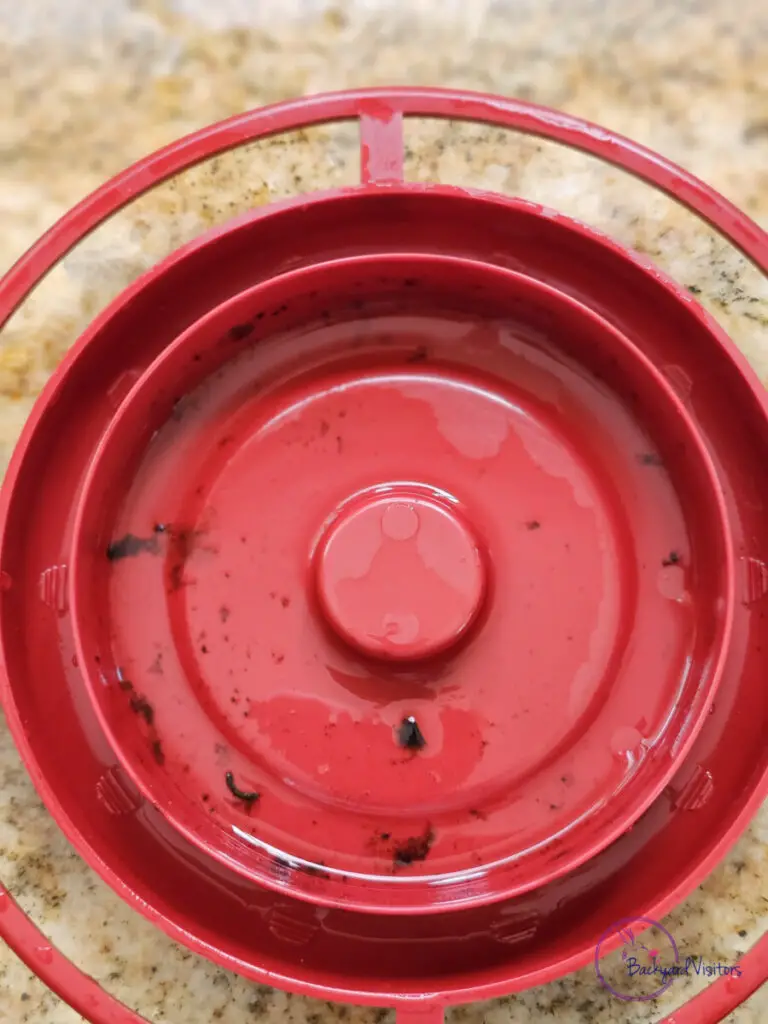
Hummingbird enthusiasts also recognize that feeder placement plays a substantial role in attracting these flitting jewels. Position hummingbird feeders amongst nectar-rich plants to create an inviting habitat that allows the birds to flit between natural food sources and your feeder offerings.
While hummingbirds are naturally drawn to flowers due to their dual offering of nectar and insects, a strategically placed feeder ensures a steady diet, particularly when blooms are sparse.
Red remains the iconic color for catching a hummingbird’s eye, which explains why many hummingbird feeders feature this vibrant hue. However, unlike flowers, where color is often directly linked to nectar production, the color of the feeders is to ensure visibility rather than taste.
To truly provide the best for your hummingbirds, it is crucial to fill your feeders with the correct sugar solution. The correct recipe is a ratio of one part sugar to four parts water which mimics a natural flower’s nectar sweetness without added dyes or flavors. In the quest for the best, hummingbirds show a clear preference for fresh, clean feeding stations.
The best hummingbird feeders are designed with broad mouths for easy pouring and thorough scrubbing. This encourages frequent routine cleaning to prevent serving fermented nectar with bacterial growth. Additionally, consider feeders with built-in ant moats or insect guards to dissuade crawling pests, ensuring that the nectar remains reserved for your intended avian audience.
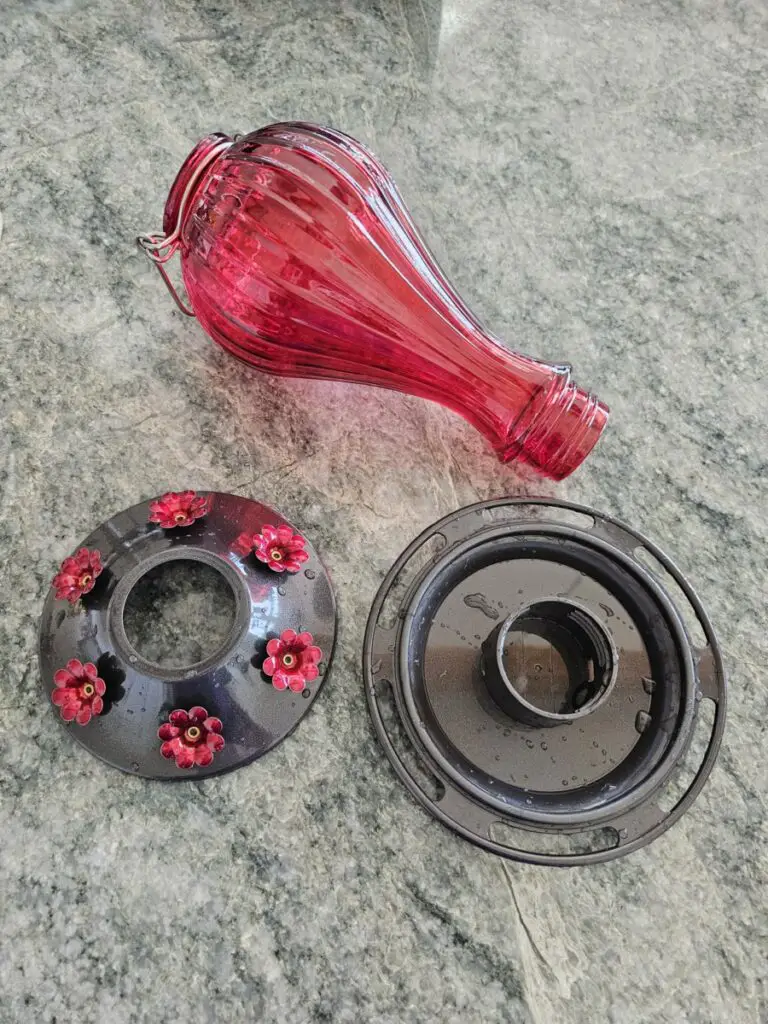
Moreover, the best hummingbird feeders are ones that stand the test of time by being made of durable materials such as glass or heavy-duty plastic. Feeders with UV-resistant properties safeguard the feeder’s integrity and nectar quality from the harsh degradation of the sun.
Therefore, by selecting the most robust feeder, you not only ensure longevity but also the health and safety of the hummingbirds.
Read my article: Red Hummingbird Feeders: (Essential or Optional)
While hummingbird feeders certainly play a pivotal role in a garden’s allure, it is vital to create a comprehensive habitat for these exquisite creatures. Marrying the feeder’s convenience of the nectar and the natural proteins the flowers attract with the perching opportunities provided by flowers bridges the gap for what hummingbirds naturally seek. As a hummingbird aficionado, crafting such a paradise ensures that your garden remains a favored spot for their swift and enchanting visits.
The art of attracting hummingbirds to your sanctuary hinges on selecting the best hummingbird feeders that meet these avian wanderers’ needs, and incorporating them into a broader strategy that includes native, flowering plants. In doing so, you are not just inviting hummingbirds to a feeder; but are welcoming them to a holistic environment that caters to their every preference—flower or feeder.
Feed Hummingbirds with the Right Food: Tips for Filling Feeders
When endeavoring to captivate the iridescent flutter of hummingbirds, many enthusiasts ponder whether hummingbirds prefer feeding at flowers or are they more enticed by the convenience of feeders? The debate is ongoing but the truth lies in their adaptive foraging behavior. While flower visits offer a robust source of natural nectar and essential nutrients, primarily visited feeders in a well-appointed garden will equally delight these agile flyers.
Creating a hummingbird haven necessitates providing an ample supply of food, which includes both the nourishing sweetness of hummingbird nectar and the charm of nectar-laden flowers. The best strategy to attract hummingbirds involves integrating a blend of both.
Installing hummingbird feeders amid a landscape vibrant with the best plants that offer food naturally helps ensure a diversified diet for your visiting hummers.
When selecting the perfect hummingbird feeders, consider the feeder’s accessibility and design—features that cater to a hummer’s predilections. The feeder should be easy to clean and fill, have leakage-proof ports to prevent messes, and be crafted to discard any potential of fermentation, which is detrimental to the hummingbird health.
Given that feeders are a plentiful source of food, one may assume that visiting feeders would completely outweigh visiting flowers. However, your feeder should only be used to augment the natural diet of flowers, offering sustenance during periods when blossoms are in short supply or as a quick fix to replenish energy.
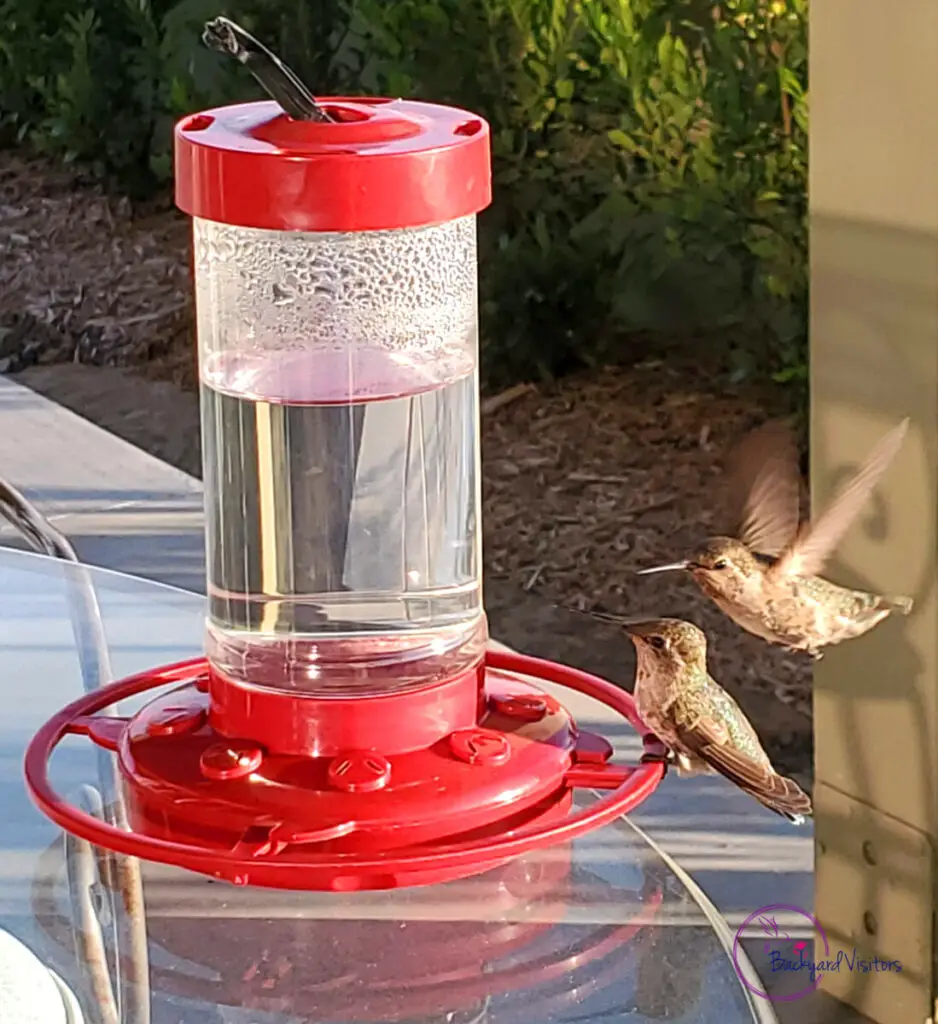
Filling your feeders with a homemade nectar solution—four parts water to one part white sugar—mimics the consistency and sweetness of natural nectar found in flowers.
Read my article: Forget Commercial Hummingbird Food, Try Making Homemade Nectar
Avoid using honey or artificial sweeteners as they will harm hummingbirds. Refrain from adding food coloring to your mixture, since the chemicals are unhealthy and the feeder itself is enough to draw the bird’s attention.
Regularly cleaning your feeders and refreshing the food is also paramount to prevent mold and bacterial growth.
For those keen on studying these enchanting creatures observing the feeders provides a delightful spectacle as the schedule of feeder visits is frequent, especially during peak migration when hummers are fueling up for long journeys.
Keep in mind that while your feeders play a significant role, the best way to mimic the birds’ natural environment and dietary needs is by cultivating a garden with the best plants known to feed hummingbirds. Examples include the Honeysuckle, Trumpet Vine, Salvia, and Bee Balm, which offer both the essential food and an invaluable habitat.
How to provide a habitat that encompasses all aspects of their needs is important. The feeder is but one component—though undoubtedly an impactful one—in the orchestra of a garden that harmoniously draws hummers with its floral abundance and ensures frequent feeder visits. In essence, whether it is feeder or flower visits, offering the right food sources is the best means to attract and nourish these remarkable birds.
When filled with the right food and accompanied by the best plants, hummingbird feeders will become a central feature in a hummingbird-friendly garden. By optimizing the placement of your hummingbird feeders and ensuring they are in close proximity to nature’s best offerings, you will no doubt witness the delightful dance of feeder activity mingled with the natural approach to feeding at flowers.
Striking this balance is not only rewarding for us as hummingbird aficionados, but also supports the wellbeing of these marvelous pollinators, making your garden a veritable hummingbird utopia.
Check out my other posts on Hummingbird Questions
Frequently Asked Questions
Q: Do hummingbirds prefer flowers or feeders?
A: Hummingbirds are naturally drawn to flowers for their nectar and essential nutrients; however, feeders will supplement their diet, especially when natural nectar sources are scarce. A garden that offers both rich floral abundance and strategically placed feeders offers the best of both worlds, catering to the hummingbirds’ varied needs throughout the seasons.
Q: What are the best plants for attracting hummingbirds to my garden?
A: The best plants for attracting hummingbirds are typically those that are native to your region and have co-evolved with local hummingbird species. Look for plants with vibrant colors and tubular shapes, such as Trumpet Vine, Salvia, Bee Balm, Cardinal Flower, Fuchsia, and Penstemon. These not only offer nectar but also attract insects, which serve as an additional food source for hummingbirds.
Q: How should I properly maintain hummingbird feeders?
A: Hummingbird feeders require regular maintenance to prevent mold and bacterial growth which will harm the birds. Clean your feeders thoroughly at least once a week, more often during hot weather, and refill with fresh nectar – a mix of one part white sugar to four parts water. Avoid using honey, artificial sweeteners, and food coloring, as these are harmful to hummingbirds.
Q: Why is it important to offer a variety of flowering plants in my hummingbird garden?
A: Offering a variety of flowering plants ensures a longer blooming season and provides continuous nectar sources throughout different times of the year. A diversity of plantings not only attracts more hummingbird species but supports a balanced diet by offering various nutrients and encourages natural foraging behaviors.
Q: Aside from nectar, what else do hummingbirds feed on?
A: In addition to nectar, hummingbirds feed on small insects and spiders which provide essential protein and fats for their diet. Flowers not only provide nectar but also attract these insects, creating a comprehensive food source for hummingbirds, especially important during breeding season for the chicks’ growth and development.
Happy Hummingbird Watching!
Backyard Visitors participates in affiliate programs which compensate us for referring traffic.

